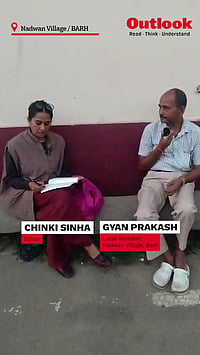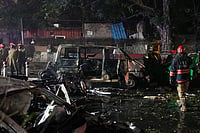Ken Juster, undersecretary of commerce and a key player on Indo-US issues,announced he is leaving the Bush Administration this month to return to theprivate sector. In a wide-ranging interview, the effervescent advocate of betterrelations between the two countries reflects on the long road traveled. Duringhis tenure, he lent his considerable weight to push the process through the USbureaucracy, overcoming many hurdles along the way.
Your decision to leave the Bush Administration has caused some concern in India because you are the second person clearly identified as a friend of India to move on. What attracted you to Indian issues?
Given my responsibilities in the U.S. government for the export of sensitive U.S. technology, India represented both a challenge and an opportunity for me. When I took office, the United States still had in place certain sanctions against India resulting from India’s 1998 nuclear tests. Indeed, because India is outside the established global nonproliferation framework, including the four multilateral regimes that deal with the exports of sensitive technology, the United States faces certain constraints on its ability to export sensitive technology to India.
At the same time, India presented an enormous opportunity because, as the world’s largest democracy, it has many interests in common with the United States, the world’s oldest democracy. Our countries should have a much broader and deeper level of engagement on a range of issues, including cooperation on the civilian applications of sensitive technologies. Along with my colleagues in the U.S.government, I tried to structure a process that could enhance the ability of our two countries to engage in high-technology cooperation, while still ensuring our security interests.
Despite the broad realization that stronger U.S.-India ties are in the fundamental interests of both countries, the potential of the U.S.-India relationship has thus far not been fulfilled. I believe that President Bush has found a way to work cooperatively with India to unlock the potential of our relationship. We are in the process of developing "habits of cooperation" on issues of mutual concern and, even more important, developing mechanisms for institutionalizing that cooperation. As a result, I leave office confident that our progress will survive the inevitable changes that occur ingovernment personnel in both countries.
How would you compare the bilateral plate today compared to when you came in?
The range of issues in our bilateral relationship today is broad and diverse. We have productive engagement in many areas, including military relations, economic and developmental matters, antiterrorism efforts, global issues such as AIDS and other health concerns, and science and technology. When I joined the Commerce Department, many of these were potential areas to be addressed, but we had not really developed the level of interaction and cooperation that we now have today.
Interestingly, our progress on the substance of our relationship is also reflected in its human interaction. For example, there has been an enormous transformation in how we conduct meetings with each other. At the outset of the Administration, meetings between U.S. and Indian officials were somewhat formal and even a bit stiff. It was as if our substantive differences made us physically uncomfortable. Now, U.S. and Indian officials are comfortable dealing with each other as colleagues, complete with humor as well as frankness, confident in the strength of the relationship. In addition, our interactions have not only advanced in form and substance, they have also increased exponentially in terms of the frequency and range of contacts between ourgovernments.
In what ways has India become an attractive destination for US investments? How do India and China compare in this regard?
India is both an attractive market for U.S. exports and an appealing destination for U.S. investments. There are many reasons for this. For example, there is the size of the Indian market, including its middle class, which holds great potential for U.S. firms seeking customers and investment opportunities. There is also the tremendous human capital in India, where graduates of Indian institutions of higher learning are as well qualified as any in the world, and much of the Indian high-technology workforce speak English. In addition, many of the top companies in India are being run in accordance with the advanced management practices and other business techniques with which U.S. business people are comfortable. This compatibility makes it increasingly easy for U.S. companies to deal with Indian companies and employees.
Nonetheless, we have only begun to scratch the surface of the full range of opportunities in the economic relationship between our two countries. Despite our recent progress, barriers remain. India must continue to open its market to investments from abroad, lower certain tariff and non-tariff barriers, and further improve its infrastructure, if it is to realize its full economic potential.
While I do not generally make comparisons between trading partners, I can point out that the United States has a real opportunity to develop a defense technology relationship with India that it cannot currently have with China because of existing restrictions on defense trade with China. Beyond that, I would note that countries that pursue sound trade policies and make a concerted effort to attract U.S. investment through a variety of incentives and other programs will be more successful in attracting American trade and investment. Again, the growth potential in India is enormous, given the size of the market, its highly qualified workforce, and the widespread use of the English language. Moreover, the business success of the Indian-American community in the United States, and the desire of many of its business leaders to be involved in the U.S.-India economic relationship is a very positive factor.
Finally, the reason why we created the High Technology Cooperation Group (HTCG) was to try to engage the private sectors in both of our countries to expand our high-technology cooperation by lowering barriers to trade and investment in India, and seeking ways to modify our U.S. export controls to facilitate such trade. In addition, the HTCG seeks to create a strong commercial underpinning for our strategic partnership. Increased commercial interaction can lead to the formation of business constituencies that have a stake in the bilateral relationship and they can help moderate problems. It is significant that India is the only country with which we have established a group such as the HTCG.
How does a strong Indo-US relationship serve American interests?
A strong Indo-U.S. relationship serves the interests of both countries. There are many areas for cooperation, including joint efforts to combat terrorism, prevent the proliferation of weapons of mass destruction, enhance the stability of Asia and the world, and increase the types of trade and investment that will enhance the prosperity of both of our peoples. That is why I am so confident in the future our the U.S.-India relationship.
If you could change things, what would you recommend to both sides in the order of priorities?
In terms of some our substantive priorities, I would hope there is a way that, together, we could find a role for India as a partner in the management of the global order, including efforts to prevent the proliferation of weapons of mass destruction. Second, I would like to see us truly realize the full potential of our economic relationship, which will inevitably require India to further open its markets, hopefully in a way that will advance the economic development of the country. Third, although the links between our respective peoples and cultures are close, I would hope to see them become even stronger.
You have seen the ups and downs of the Next Steps in Strategic Partnership. What were they and how were they overcome?
It is essential that we view the Next Steps in Strategic Partnership (NSSP) not only as a series of substantive goals, but as a process for strengthening our relationship. In this respect, the NSSP has been an unqualified success.
The essence of the Next Steps should not be a negotiation in which each side believes that it is trying to "extract" something from the other side, but rather a series of reciprocal steps to build on the mutual interests of the two countries. In other words, India should be taking steps to strengthen its controls on the export and transfer of sensitive technology not as a "favor" to the United States, but because it is in India’s own interest to do so. In addition, such steps will enable the United State to have the confidence that it needs to increase the level and scope of technology exported to India, which is something that is ultimately in our interest. In short, the NSSP can and should be a "win-win" process for both countries.
Moreover, as the bureaucracies of both governments increasingly work together on these issues, we should develop "habits of cooperation" that will build upon themselves and allow us to take further steps to develop our high-technology relationship. The NSSP is also designed to send a strong signal to both publics of the twogovernments’ commitment to moving forward.
Throughout the NSSP process, it is important that, as difficult issues arise, they are taken in stride as challenges to be met, and are not viewed as litmus tests for the entire relationship. We have reached the point where we have a broad set of relations, and any differences that arise can and should be managed within those relations, while we continue to move forward on matters of common interest and concern. We should not overreact to problems, because such occurrences are inevitable in relations between any two great countries.
Do you think Indo-US relations still are driven primarily by personalities or is the process strong enough to withstand the absence of active advocates of better relations such as yourself?
Fundamentally, U.S.-India relations must be based on underlying common interests, which I believe we share and are enduring. This, more than anything else, gives me confidence that our relationship will continue to grow.
Of course, personalities will always play a role in any set of policies or relations, but it is my fervent hope and strong belief that we have also put in place a framework and a series of processes for addressing issues of mutual concern that rise above personalities and will allow us to institutionalize the many components of our relationship.
When I look back on my trip to India in November 2002, when we established the High Technology Cooperation Group, I notice that no one with whom I met on the Indian side at that time is currently involved in this process. They have moved on and an entirely new team is in place, yet, the HTCG process moves forward with a full agenda. It’s the same story with the NSSP. We began it with one Indiangovernment, and completed Phase One with a different one. This indicates we have already begun to institutionalize our relationship beyond the personalities who are involved in any one set of issues. It is only natural that this transition will also occur over time on the U. S. side, even as President Bush enters his second term and some key players in our relationship with India remain in thegovernment. I feel confident that we have established sufficiently strong processes for both the NSSP and the HTCG that these initiatives will continue to move forward.
Do you think New Delhi’s decision not to send troops to Iraq had an adverse impact on Indo-US relations?
It is less that New Delhi’s decision against sending troops to Iraq had an adverse impact on Indo-U.S. relations, than the fact that India missed an opportunity to accelerate the process of lifting our bilateral relationship to a new level. Nevertheless, I am confident that there will be other types of opportunities in the future to take dramatic steps forward in our relationship. It is up to the twogovernments to seize such opportunities.
The Bush Administration apparently has no objections in selling F-16s to Pakistan and the Patriot anti-missile system to India. Does it mean the US doesn’t see South Asia as a nuclear flashpoint anymore?
Any decisions that the U.S. government makes with regard to the sale of certain defense items to either India or Pakistan are based on a number of factors, including an assessment of the impact of such decisions on regional stability, with a desire not to upset that stability. I think that any objective assessment of the situation in South Asia would have to include concerns over the potential use of nuclear weapons, given the historical tensions in that region.
Some Indian personalities, particularly former foreign minister Jaswant Singh, have been critical of the NSSP as signed in Washington. They say it is a premature baby. It promised more than it delivered. Your comments?
It would be a mistake to either oversell or undersell the NSSP. It certainly is not a "premature baby," but neither is it the final word in our high-technology relationship. The NSSP is a way for our two countries to cooperate with each other that holds the promise -- but not the guarantee -- of great achievements. The NSSP represents a fundamental change in how the two countries approach the relationship with each other and provides a mechanism for building confidence and cooperation on a step-by-step basis.
Does the NSSP signal US acceptance of India’s nuclear and missile programmes?
The NSSP recognizes the reality of the situation on the ground in India, including the fact that India has nuclear and missile programs. The United States will not in any way contribute to the advancement of those programs, but will look for ways to cooperate in civilian space and civilian nuclear activities, while enhancing export controls and nonproliferation objectives.
Some critics say that the NSSP basically serves US interests in aligning Indian export control laws to American needs.
The NSSP is designed to serve the mutual interests of the United States and India. Indeed, when President Bush and Prime Minister Singh met in September 2004 to announce the conclusion of Phase One of the NSSP, Prime Minister Singh stated that "our two countries’ relations have grown in diverse ways, but I do believe that the best is yet to come."
With regard to the critics, it is simply a mistake to look at the NSSP as an advantage for one country or the other. The NSSP is designed, in part, to enhance certain security measures in India, including export controls. As thegovernment of India has itself recognized, this step is in India’s interest. Security measures, including effective export controls, are a necessary foundation for international commerce. Indeed, the international community has acknowledged the importance of national export control laws in United Nations Security Council Resolution 1540. But the benefits to India go beyond greater security through stronger export controls. As India takes steps to strengthen these security measures, the United States, under the NSSP, will be able to export to India increased levels of high-technology items.
Are you satisfied with the firewalls in ISRO to prevent proliferation?
I cannot get into specific issues relating to entities in India, such as the Indian Space Research Organization. The United States and India discuss these types of matters of mutual concern on a regular basis. That is one of the benefits of our strengthened relationship.
When are sanctions on ISRO’s subsidiaries likely to be removed?
It is incorrect to say that there are sanctions on ISRO subsidiaries. Rather, we simply have licensing requirements for those subsidiaries, and, in practice, there is a very high rate of approval for license applications to them. Certain ISRO subsidiaries, and only certain ones, have been placed on the U.S. Department of Commerce Entity List because they have been involved in programs of concern. In September 2004, the U.S.government removed ISRO Headquarters from the Entity List and significantly eased licensing requirements for ISRO subsidiaries. However, I am not in the position to comment on if or when certain ISRO subsidiaries will be removed from the Entity List.
The US named two Indian scientists on the sanctions list but the government of India says the US is completely off the mark. What is the evidence against them and is there a "reconsideration" of the case? Do you think they could be removed from the list soon?
I cannot comment on issues that are currently being discussed by our two governments.
It is said that China has better access to US high-technology despite its proliferation record of having supplied nuclear technology to Pakistan. Is it because China has signed the NPT and India hasn’t?
Overall, U.S. export licensing policy is less restrictive toward India than it is toward China. For example, there currently is a ban on U.S. exports of defense articles and defense services to China, whereas the United States would like to expand such exports to India. However, for a certain set of limited items, the export regulatory regime is more favorable to countries that have ratified the Nuclear Nonproliferation Treaty, such as China, than for countries that have not, such as India.
You head the High Technology Cooperation Group which has two components -- strategic trade and high-tech trade for commercial purposes. Are you satisfied with the progress in the latter because there is not much to show after two years?
Within the U.S.-India High Technology Cooperation Group, there has been more progress on strategic trade issues than on reducing tariff and non-tariff barriers to such trade in India. Accordingly, it is important that this latter element of the HTCG also be actively addressed by thegovernment of India in order to increase high-technology trade between our two countries. For example, the United States would like to see customs procedures in India simplified, as well as certain Indian technical standards addressed so as not to be a hindrance to high-technology trade.
How do you see India's record on export control in what is described as "deemed export" or "intangible"?
One of the major challenges in the area of export controls is not just to control the export of sensitive goods and products, but also to control the export of technology and know-how -- what are known as "intangibles." In addition, there is the extra challenge of controlling the transfer of such intangibles to foreign nationals, what are known as "deemed exports.
























